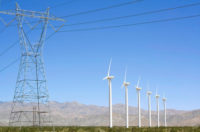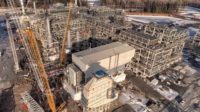In executing a White House goal to upgrade 100,000 miles of transmission lines in the next five years and address reliability concerns in advance, the U.S. Dept. of Energy announced a flurry of eased permitting mandates and funding boosts for new projects to meet growing power demand and deliver low-cost, cleaner energy. These include permit exclusions for projects in existing rights-of-way and one-stop federal environmental reviews with hard deadlines.
The changes are part of what the Biden administration calls “aggressive action” to accelerate project permit reviews across all infrastructure development, announced April 30.
In a final rule announced April 25, DOE created the Coordinated Interagency Transmission Authorization and Permits program to combine multiple federal agency environmental impact reviews into a single document that must be completed in two years.
The agency will have lead role in federal reviews and approvals for all high-voltage transmission projects above 230 kV. The program “will add much-needed efficiencies to the permitting of high-voltage lines while also ensuring early and meaningful community engagement,” says Elise Caplan, American Council on Renewable Energy vice president of regulatory affairs.
DOE also added a “categorical exclusion” for mandated review of power line upgrades and repowering under the National Environmental Policy Act (NEPA) for those located in an existing right of way with likely minimal environmental impact.
“With this final rule, DOE removes the mileage limitation, adds options for relocating within an existing right-of-way or within otherwise previously disturbed or developed lands [and] specifies conditions for widening a right-of-way,” the agency said.
The overall permitting rule, including for transmission and energy projects, will apply only to projects that start environmental reviews on or after July 1.
“We are acting with the urgency the American people deserve to realize a historic rework of the permitting process that slashes times for new transmission lines … and meets the energy needs of today and the future,” said Energy Secretary Jennifer M. Granholm.
Transmission construction over the past decade was done at half the rate it was in the previous 30 years, often the result of permitting and financing issues, DOE said.
Ken Nolan, general manager of the Vermont Public Power Supply Authority, says one key delay factor is no set time frame for when other stakeholders, such as environmental groups, can seek more impact studies.
‘Binding Two-Year Timeline’
DOE said it will use an interagency pre-application process to ensure project submissions are ready for review in a “binding two-year timeline.” It claimed this will not compromise NEPA protections and non-DOE agency permit mandates. State authorities can also participate.
The White House touted recent energy projects for which NEPA reviews were completed in less than two years—“from notice of intent to record of decision”—including the multibillion-dollar Sun Zia transmission project, 200-MW Dry Lake East Energy Center solar and storage project and 400-MW Cape Station Exploration Drilling geothermal energy project.
The agency also is piloting use of artificial intelligence tools to streamline permit processes and improve project siting, said the White House, with DOE issuing a report on use of AI tools to modernize grids and add renewable energy, but also cautioning key risks, including to supply chains.
According to Bloomberg, about $30 million has been allocated from the 2021 infrastructure Act for government-wide AI investment to improve permitting. The U.S. Interior Dept. is the single largest agency beneficiary, set to gain $11 million.
“This rule is a significant step forward in bringing coordination and accountability into the permitting review of these vital projects,” said Eric Beightel, executive director of the federal Permitting Council and a former HDR Inc. associate vice president and its national lead for infrastructure policy and environmental strategy.
But the Natural Resources Defense Council said in a statement that DOE “did not adopt our recommendation that the rule allow for environmental and public interest groups to be involved in the pre-application process.”
Project Funding
DOE said grid upgrades include repowering lines by replacing components with newer technology that adds capacity and reduces need for new construction. Recent research found that large-scale reconductoring—replacing the conductive core of a transmission line with modern materials to increase carrying capacity—could improve the ability to connect renewable projects near an existing transmission network, according to DOE.
Project funding is available through DOE's Grid Resilience and Innovation Partnership program, which recently closed applications for up to $2.7 billion in new federal grant funding. Administration officials last year announced $3.46 billion in funding awarded for 58 projects across 44 states.
DOE also released the Innovative Grid Deployment Liftoff report to provide pathways to deploy commercially available technologies to support 20 GW to 100 GW of peak demand, and the Transmission Interconnection Roadmap to reduce wait times for power generation grid connections.
DOE also provided up to $331 million to support construction of the $1-billion Southwest Intertie Project—a 285-mile, 500-kV line set to carry wind energy between substations in Idaho and southern Nevada. It would add more than 2 GW of new regional capacity, including 1 GW along a major transmission corridor in southern Utah, and be an alternate route during wildfires or other system disruptions.
Construction, set to begin in 2025 and finish in 2027, includes an upgrade of the Nevada substation. The project is the final section of a three segment line that extends the reach of California grid operator CAISO across Nevada into Idaho, said project owner LS Power Corp. Other segments, totaling about 291 miles, were built in 2014 and 2020.
DOE can borrow up to $2.5 billion under a program to purchase up to 50% of capacity from Southwest Intertie Project North and other eligible lines for 40 years—a move aimed at lowering construction risk and increasing investor confidence. The agency, which will serve as the anchor tenant, is finalizing contracts for two Southwest U.S. transmission projects selected last year under that program that will start construction in 2025—Southline Transmission Project and Cross-Tie Transmission Line.
The government also noted completion of the 3.2-GW, 125-mile Ten West Link transmission line this month, to extend from Arizona to California. The U.S. Interior Dept., which approved its construction in 2022, also announced new measures to reduce costs and schedules for clean energy projects on public lands.
Additionally, the Federal Energy Regulatory Commission, the independent agency that regulates interstate power transmission, is expected to approve May 13 a new planning and cost allocation rule that includes requirements to site projects in “national interest corridors.” Chairman Willie Phillips said more than 70% of the country’s bulk power system was built in the 1950s and 1960s. “We have to act now. Our communities that suffer during extreme weather cannot wait,” he said.
Stakeholders are watching closely what FERC does.
“Previous FERC efforts to modernize and standardize transmission planning ... ultimately failed to produce ... significant regional transmission projects because the agency allowed utilities to bypass regional planning in favor of local upgrades,” said Cullen Howe, NRDC senior clean energy transmission advocate. “Without strong follow-up federal action, we risk continuing on the same path. FERC must not let this opportunity go to waste.”







Post a comment to this article
Report Abusive Comment